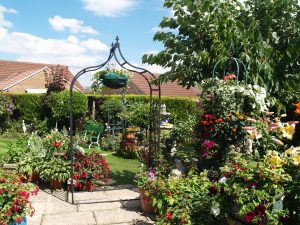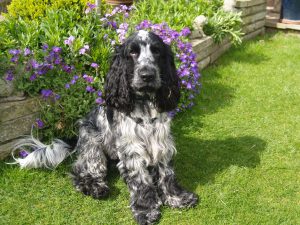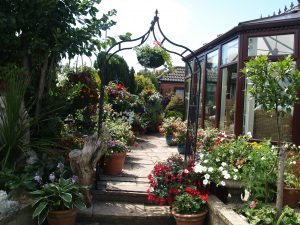Dog Friendly Gardens – Tips for Dog Owning Gardeners
Maintaining a pristine garden and lush lawn can sometimes be an issue for keen gardeners who also own dogs. How many of you have rushed behind the ‘tinkling’ dog with a watering can to prevent the lawn developing quite so many burnt brown circles?! It is possible for the two to be compatible, so Holidays4Dogs has compiled some tips for dog owning gardeners. Many of our carers have absolutely stunning gardens so it can be done! Read on to find out more about dog friendly gardens.
Fencing.
This is the most important consideration when thinking about garden design and keeping dog’s safe. Holes and gaps in fences encourage dogs to poke their noses through. This might not endear them to your neighbour, or your neighbour’s dogs, (if you have them).
Good solid panel fencing is ideal, but well erected chain link fencing or post and rail stock fencing with wire infill is equally suitable. Open fencing can be made more pleasing to the eye by growing climbers or shrubs in front.
If you have access gates into your garden, security is important. This will guard against people entering unexpectedly, or the gate accidentally being left open. Some persistent dogs can work latches loose themselves, so this is a point to bear in mind, depending on the dog. In general, it is safer not to leave your dog unattended alone in the garden. Indeed, this is something our Holidays4Dogs carers will never do.
Ponds and pools.
Ponds are a delightful feature of gardens, but also very attractive to dogs! Some ponds are large enough and constructed solidly enough for dogs to swim in and, indeed, many of our carers own natural ponds in their grounds.
However, do beware of water quality. Stagnant ponds, or ponds where rats have access to, for example, are not suitable for dogs to swim in.
It is a good idea to consider covering smaller ponds with netting. Plastic lined ponds are easily punctured by dogs’ claws, so it is important to protect your pond and most especially if it contains fish and other pond creatures.
Lawns.
When we think of dog friendly gardens, we often think of a lovely grassy play area for the dog to run around. However, unless you have acres and acres of land – (many of our lovely carers do!), this can be one of the trickiest areas to maintain when you own dogs. Female dogs tend to do the most damage to lawns. They tend to squat on open areas of lawn and their urine seems to do the most damage.
Using the old watering can technique can work well. This dilutes any urine patches and helps to stop the grass becoming burnt. Having a few full cans around the garden means you can quickly deal with a patch the dog has just used.
Alternative surfaces.
You can have different surfaces other than grass in dog friendly gardens. You may want to think about allotting an area for ‘spending’ while at home. It is a relatively simply procedure to teach a dog to use a specific area. This could be an area of wood chippings, sand, gravel or, even concrete – (although many dogs are usually reluctant to use bare concrete).
Take the dog to the spot on the lead and, each time, and use a key word, such as ‘hurry’ or, ‘be quick’. Praise lavishly once the dog has performed and the dog will very quickly learn to use their own spot. To help you along the way, you might consider fencing this section off temporarily. Only let the dog onto the main garden, once he has performed.
Of course, taking your dog out regularly so he can empty his bladder and bowel cuts down on the impact on your garden. However, always remember to pick up any deposits while out and about.
A radical alternative to real grass is a synthetic lawn. We do have one carer who has such a lawn. It really does look great and very close to the real thing.
Good quality synthetic lawns doesn’t necessarily come cheap, but they extremely hard wearing and can be hosed down and disinfected with a suitable product periodically. When shrubs and flowers soften the edges ‘fake’ lawns can look really authentic and can make for great dog friendly gardens.
Paving and other materials.
Dogs do like to run around the perimeter of gardens and this can mean certain patches become eroded, or muddy. A good idea is to pave, or gravel the paths that your dog usually likes to take. Bark chippings work well on beds or pathways and can help stop the ground becoming quite so churned up. However, do not use the cocoa shell type as this is very poisonous to dogs.
Pots and Plants.
Flower pots and hanging baskets prevent your dog from digging plants up in the ground. You could consider providing your dog with sandpit of his own, which may help to discourage him from digging. This is a great idea for dog friendly gardens.
Large pots filled with flowers are usually ignored by dogs. However, male dogs will sometimes mark territory, so it’s a good idea to get one tall enough, so that any urine cannot actually get into the top of the pot.
Plants can be protected by canes and netting, especially while they are young. Some dogs, however, are allergic to bee stings so it is always worth considering this when planting.
Vegetable plots are also very attractive to dogs and they will often dig up unexposed vegetables. Be aware that potato sprouts in particular are toxic to dogs. Additionally, dogs should not be allowed anywhere near fertilisers, or insecticides.
The best policy for vegetables and dog friendly gardens is to fence the whole area off so your dog cannot have free access. There are a few garden plants that are toxic to dogs – you can find out more here.
Conclusion.
For dog owning gardeners, it is possible with a little planning, to have a stunning garden and keep a dog, or dogs. The proof is in the pudding as all the photographs in this article belong to one of our regular Holidays4Dogs carers. Their garden is an award winning stunning showpiece.





